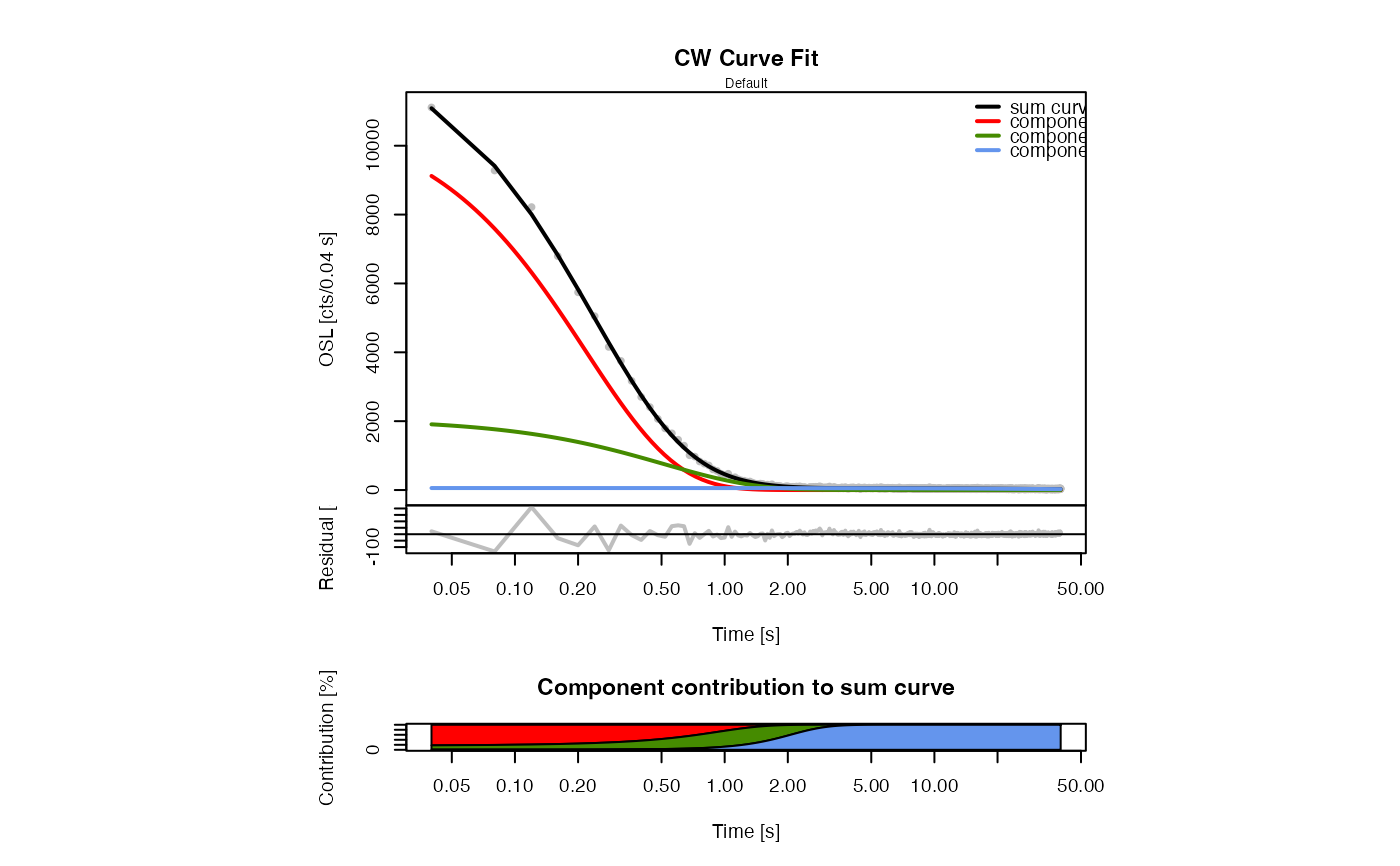The function determines the weighted least-squares estimates of the component parameters of a CW-OSL signal for a given maximum number of components and returns various component parameters.
Fitting function
The function for the CW-OSL fitting has the general form:
$$y = I0_{1}*\lambda_{1}*exp(-\lambda_1*x) + ,\ldots, + I0_{i}*\lambda_{i}*exp(-\lambda_i*x) $$
where \(0 < i < 8\)
and \(\lambda\) is the decay constant
and \(I0\) the initial number of trapped electrons.
(for the used equation cf. Boetter-Jensen et al., 2003, Eq. 2.31)
Start values
Start values are estimated automatically by fitting a linear function to the logarithmized input data set. Currently, there is no option to manually provide start parameters.
Goodness of fit
The goodness of the fit is given as pseudoR² value (pseudo coefficient of determination). According to Lave (1970), the value is calculated as:
$$pseudoR^2 = 1 - RSS/TSS$$
where \(RSS = Residual~Sum~of~Squares\)
and \(TSS = Total~Sum~of~Squares\)
Error of fitted component parameters
The 1-sigma error for the components is calculated using the function stats::confint. Due to considerable calculation time, this option is deactivated by default. In addition, the error for the components can be estimated by using internal R functions like summary. See the nls help page for more information.
For details on the nonlinear regression in R, see Ritz & Streibig (2008).
Usage
fit_CWCurve(
values,
n.components.max = 7,
fit.failure_threshold = 5,
fit.method = "port",
fit.trace = FALSE,
fit.calcError = FALSE,
LED.power = 36,
LED.wavelength = 470,
cex.global = 0.6,
sample_code = "Default",
verbose = TRUE,
output.terminalAdvanced = TRUE,
plot = TRUE,
method_control = list(),
...
)Arguments
- values
RLum.Data.Curve or data.frame (required): x, y data of measured values (time and counts). See examples.
- n.components.max
vector (optional): maximum number of components that are to be used for fitting. The upper limit is 7.
- fit.failure_threshold
integer (with default): limits the failed fitting attempts.
- fit.method
character (with default): select the fit method, either
"port"to use the 'port' routine from function nls, or"LM"to use the Levenberg-Marquardt algorithm as implemented in function minpack.lm::nlsLM.- fit.trace
logical (with default): traces the fitting process on the terminal.
- fit.calcError
logical (with default): calculate 1-sigma error range of components using stats::confint
- LED.power
numeric (with default): LED power (max.) used for intensity ramping in mW/cm². Note: The value is used for the calculation of the absolute photoionisation cross section.
- LED.wavelength
numeric (with default): LED wavelength used for stimulation in nm. Note: The value is used for the calculation of the absolute photoionisation cross section.
- cex.global
numeric (with default): global scaling factor.
- sample_code
character (optional): sample code used for the plot and the optional output table (
mtext).- verbose
logical (with default): enable/disable output to the terminal.
- output.terminalAdvanced
logical (with default): enhanced terminal output. Only valid if
verbose = TRUE.- plot
logical (with default): enable/disable the plot output.
- method_control
list (optional): options to control the output produced. Currently only the 'export.comp.contrib.matrix' (logical) option is supported, to enable/disable export of the component contribution matrix.
- ...
further arguments and graphical parameters passed to plot.
Value
plot (optional)
the fitted CW-OSL curves are returned as plot.
RLum.Results object
Beside the plot and table output options, an RLum.Results object is returned.
fit:
an nls object ($fit) for which generic R functions are
provided, e.g. summary, stats::confint, profile. For more
details, see nls.
output.table:
a data.frame containing the summarised parameters including the error
component.contribution.matrix:
matrix containing the values for the component to sum contribution plot
($component.contribution.matrix).
Produced only if method_control$export.comp.contrib.matrix = TRUE).
Matrix structure:
Column 1 and 2: time and rev(time) values
Additional columns are used for the components, two for each component,
containing I0 and n0. The last columns cont. provide information on
the relative component contribution for each time interval including the row
sum for this values.
Note
Beta version - This function has not been properly tested yet and should therefore not be used for publication purposes!
The pseudo-R² may not be the best parameter to describe the goodness of the
fit. The trade off between the n.components and the pseudo-R² value
is currently not considered.
The function does not ensure that the fitting procedure has reached a global minimum rather than a local minimum!
How to cite
Kreutzer, S., 2025. fit_CWCurve(): Nonlinear Least Squares Fit for CW-OSL curves -beta version-. Function version 0.5.5. In: Kreutzer, S., Burow, C., Dietze, M., Fuchs, M.C., Schmidt, C., Fischer, M., Friedrich, J., Mercier, N., Philippe, A., Riedesel, S., Autzen, M., Mittelstrass, D., Gray, H.J., Galharret, J., Colombo, M., Steinbuch, L., Boer, A.d., 2025. Luminescence: Comprehensive Luminescence Dating Data Analysis. R package version 1.1.2. https://r-lum.github.io/Luminescence/
References
Boetter-Jensen, L., McKeever, S.W.S., Wintle, A.G., 2003. Optically Stimulated Luminescence Dosimetry. Elsevier Science B.V.
Lave, C.A.T., 1970. The Demand for Urban Mass Transportation. The Review of Economics and Statistics, 52 (3), 320-323.
Ritz, C. & Streibig, J.C., 2008. Nonlinear Regression with R. In: R. Gentleman, K. Hornik, G. Parmigiani, eds., Springer, p. 150.
Author
Sebastian Kreutzer, Institute of Geography, Heidelberg University (Germany) , RLum Developer Team
Examples
##load data
data(ExampleData.CW_OSL_Curve, envir = environment())
##fit data
fit <- fit_CWCurve(values = ExampleData.CW_OSL_Curve,
main = "CW Curve Fit",
n.components.max = 4,
log = "x")
#>
#> [fit_CWCurve()]
#>
#> Fitting was finally done using a 2-component function (max=4):
#> ------------------------------------------------------------------------------
#> y ~ I0.1 * lambda.1 * exp(-lambda.1 * x) + I0.2 * lambda.2 * exp(-lambda.2 * x)
#>
#> I0 I0.error lambda lambda.error cs cs.rel
#> c1 3286.482 NA 3.83973077 NA 4.50793e-17 1.0000
#> c2 2189.251 NA 0.03752296 NA 4.40528e-19 0.0098
#> ------------------------------------------------------------------------------
#> pseudo-R^2 = 0.9987
